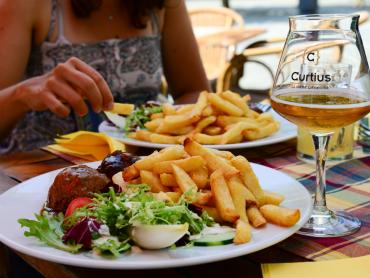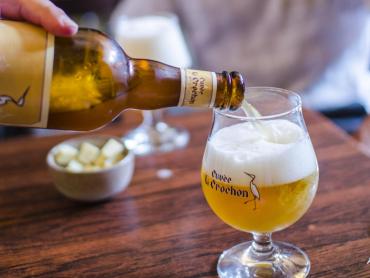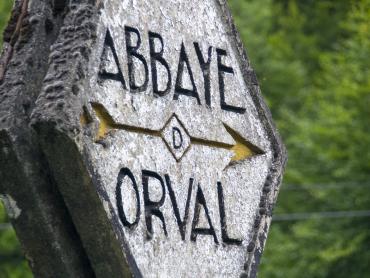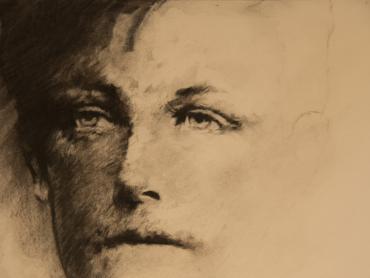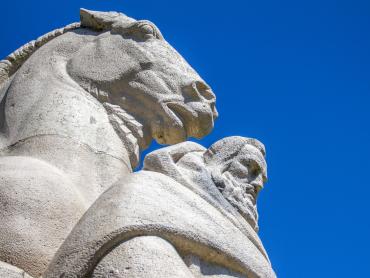Freyr, Waulsort, Hastière, Falaën
À Freyr
A - Freyr : Castle and Gardens Voir sur la carte

French-style classicism
While the fortresses of the Meuse valley stand on rocky spurs, that of Freyr, on the banks of the Meuse, was built to protect the ford crossing that served as a border between the Prince-Bishopric of Liège and the earldom of Namur, two constantly feuding states. It was to prove easy prey for the French troops of the Duke of Nevers, who destroyed it.
In the 16th and 17th centuries, tired of these feudal wars, the lords of the manors aspired to realise the sweet dream of “living nobly”. The architecture of the fortresses changed. Windows were opened and pleasure gardens replaced high walls. Freyr was no exception to the rule: it was to be rebuilt as a residence in 1571. Its garden was an ode to French classicism. Its geometry broke with the rugged landscape of the surrounding area. On the banks of the Meuse, Freyr Castle and its Renaissance style have lit up the valley for over 400 years.
Freyr,12
5540 Hastière
Tel : 0032(0) 82 22 22 00
Web : http://www.freyr.be
Did you know?
In the summer months the orange trees, which are over 250 years old, come out of the orangery and line the avenues of the geometric garden. Visiting Freyr is a pleasure for the senses.
À Waulsort
B - The abbey Voir sur la carte
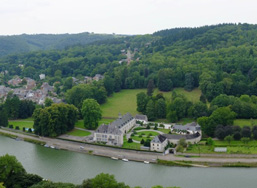
An island tossed onto the river a deserves a berthing point. And so they built … an abbey! The local lord, Eilbert de Florennes, went and fetched 12 monks from Ireland to evangelise the region. These men of the north, led by Maccalan, laid the first stones of the Benedictine abbey in Waulsort. An abbey that was to experience a great destiny, extending its powers beyond the Condroz region. All that remains of the Benedictine abbey are the cloister walls and the palace, converted into a residential castle.
Did you know?
Unlike the remote abbeys of the Ardennes forest, living on wood and cleared land, those on the banks of the Meuse benefited from dues collected for crossing the river, earning themselves ample profits...
À Waulsort
C - Walk Voir sur la carte
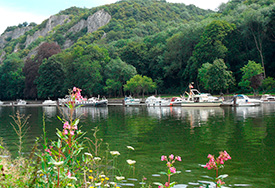
Le château Thierry
Creepers and ivy conceal a fortress forgotten by history. And yet in the Middle Ages, Château Thierry was one of the most powerful fortresses in the region! Perched on a rock spur, the castle overlooked the Meuse valley and its trade. The lords had no scruples about demanding ransoms from the traders and imposing passage duties on their boats. Château Thierry also provided protection for Waulsort Abbey, which stood at its feet: spiritual and lordly power provided mutual assistance.
Bon plan
De Waulsort, traversez la Meuse avec le bac et rejoignez cette belle balade assez physique. De beaux points de vue mènent aux ruines de château Thierry imbriquées dans la végétation. La fin de la promenade est superbe, en longeant la plaine alluviale de la Meuse.
Carnet pratique
Kilomètres : 3 km
Balisage : losange jaune
Difficulté : moyen, chaussures de rando conseillées !
Durée : 2h
Départ : débarcadère du passeur d'eau (auberge et panneau des balades).
Pour aller plus loin
Carte de promenades d'Hastière-sur-Meuse
À Hastière
D - Hastiere : The Romanesque abbey church Voir sur la carte
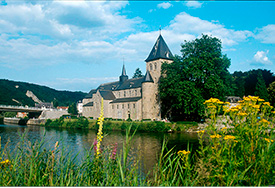
In the 11th century Irish monks settled on the banks of the Meuse and founded a Benedictine monastery there. This expanded over the centuries, encountering success and rivalries.
Built in 1033-1035 in the Mosan Romanesque architectural style, the abbey church was part of this abbey, established at its side until the 18th century. The Romanesque apse was demolished between 1260 and 1264 and a Gothic chancel with a remarkable ribbed vault was added to the abbey church.
Part of the monastery was burnt down by the Huguenots in 1568 and it was totally destroyed by the Revolutionaries in 1793. Restored in the 19th century, the abbey church is now one of the finest monuments of Romanesque art in Belgium. It symbolises faith, history and the vicissitudes of men.
Visitors will discover prestigious testimonies of history, including examples of Romanesque and Gothic art, stalls with misericords dating from 1443, wall paintings, tombstones, an outstanding statuary (Romanesque Virgin, sculptures by Lambert Lombart, 16th-century Calvary, triptych by Auguste Donnay) and even contemporary works of art, such as a Vietnamese Stations of the Cross.
But what really makes an impression is the richness of the crypt beneath the altar: Merovingian sarcophaguses, 12th-century graffiti, ancient reliquaries and many other remnants of the old abbey make visitors aware of its past and its roots.
Today every stone, every architectural element, every sculptured object evokes a particular view of the world and of mankind.
Route de Blaimont (face au n° 1) - Rue Moussia (face au n° 150)
5541 Hastière
Tel : 0032(0) 82 64 46 22
Web : http://www.patrimoinehastiere.be
À Hastière
E - The Hastière House of Heritage Voir sur la carte
A visit to this “workshop of the local memory” reveals around thirty professions represented by a wide range of tools and objects, mainly from the 19th and 20th centuries.
All these old items bear witness to a past that was ingenious but also laborious. They were created by men and women with their hands, their intelligence and their know-how.
In Hastière Museum, the working techniques and tools of times gone by are exhibited in various categories of themed collections: rural life, life on the river and industrial life.
Rue Marcel Lespagne,70
5540 Hastière
Tel : 0032(0) 82 64 46 22
Web : http://www.patrimoinehastiere.be
À Hastière
F - Reception and tourist information site Voir sur la carte
Office de Tourisme d'Hastière– www.hastiere.be
À Falaën
G - The ruins of the fortified castle of Montaigle Voir sur la carte
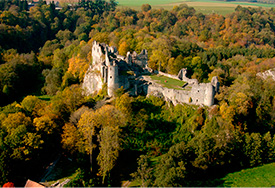
Montaigle: a name straight from the Middle Ages. Standing on an abrupt, rocky spur overlooking the pretty Molignée valley, the Montaigle site is one of the loveliest examples of the medieval castle so dear to the Romantics. Unfortunately, it depended on the Dukes of Burgundy. It was destroyed by the troops of Henry II in 1554. It was never rebuilt, but nevertheless retains all its majesty.
Contact
Rue du Marteau,10
5522 Onhaye
Téléphone = 0032(0) 82 69 95 85 ou 0032(0) 478 06 30 68
Mail = info@chateau-fort-de-montaigle.be
Web : chateau-fort-de-montaigle.be
Did you know?
At the foot of the castle, you can take the famous Molignée draisine or railbike, a flat-bottomed wagon that can be pedalled to the old Maredsous railway station. A beautiful RAVeL runs alongside, a cycle path to Anhée abbey on the banks of the Meuse.
Walking
A walk leaving from Falaën, one of the ‘Most Beautiful Villages of Wallonia’, takes you to Montaigle. Going along the winding road that rises and dips through the Namur Condroz, the route enters the woods, following the Floyon stream. At the farm in Montaigle, the path bends and heads towards the powerful fortress.
Practical details
Distance: 8 km
Waymarking: green and white rectangle
Difficulty: easy
Time: 3 h
Start: Place de Falaën
To go further afield…
« Anhée » walking map
Exploring the village : www.beauxvillages.be
À Sosoye
H - The homeland of the « Montagnards » Voir sur la carte
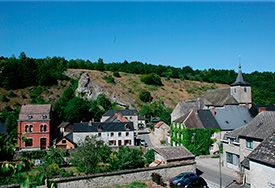
The chalky mountain of Ranzinelle overlooking Sosoye is an anthem to pastoralism and the sun. Bare of forest, it is covered with dry fields of grass and astounding calcicolous and xerophile plants. At its feet, the village of Sosoye displays its pretty limestone façades, encircling the tithe barn and the 18th-century church.
Walking
The walk through the chalky fields of grass seeks to conquer this mountain! The reward is a magnificent beauty spot.
Practical details
Distance: 7 km
Waymarking: green and white rectangle
Difficulty: average
Time: 2.30 h
Start: place de Sosoye
To go further afield…
« Anhée » walking map.
Exploring the village :
www.meusemolignee.be
www.beauxvillages.be
Meet and savour
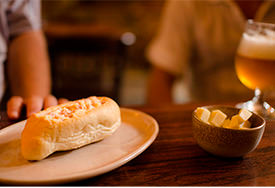
Beer and bread at Li Crochon
In days gone by, Li Crochon was the first and the last crust of bread, spread with cheese and warmed over a wood fire. This dish, now in modern form, has become a roll scooped out and filled with ham, cheese (Chertin from the Chertin cheese dairy farm in Falaën) and fresh cream, then warmed in the oven. This delicious speciality, like the simple dishes that are as old as the hills, can of course best be savoured with the Li Crochon cuvee, a good-quality brown or blonde beer made of pure malt and hops, fermented in the bottle and brewed in the Bocq region.



